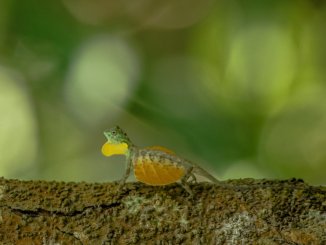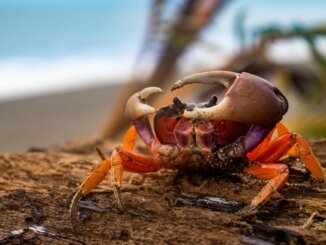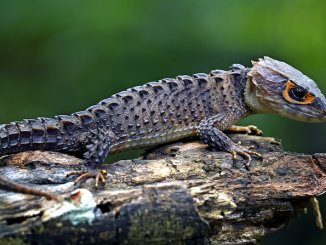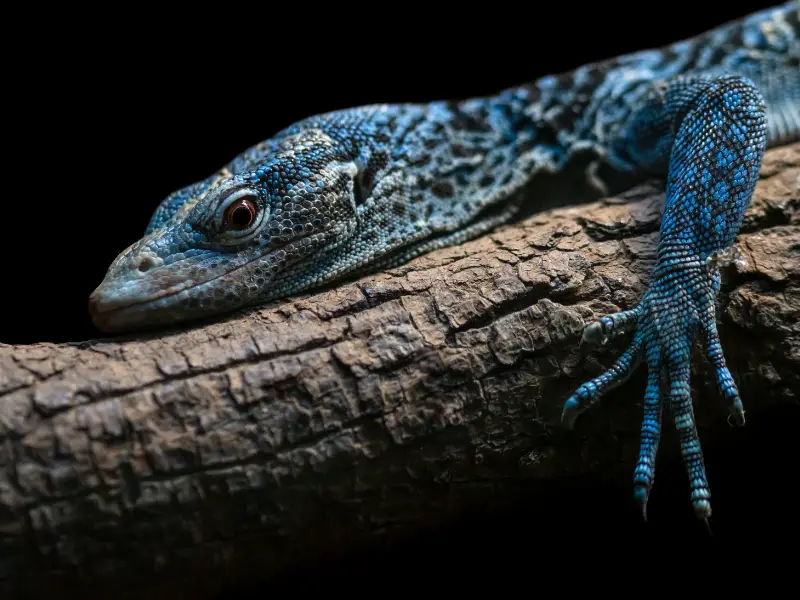
The blue tree monitor is a large reptile from Indonesia that is famous for its striking blue coloring. These solitary creatures prefer not to be over-handled and love adventuring and climbing in their large enclosures.
Blue tree monitors are best suited to intermediate and experienced reptile owners as quite a lot goes into keeping them happy and healthy. Here’s what you need to know about caring for one of these beautiful reptiles.
Blue Tree Monitor Overview
| Common name | Blue Tree Monitor; Blue-spotted Tree Monitor |
| Scientific name | Varanus macraei |
| Natural habitat | Tropical rainforests |
| Adult size | 42” for adult males and 38” for adult females |
| Average lifespan | 10 - 15 years |
| Diet | Omnivores (insects like crickets, grasshoppers, and roaches, and green vegetables like lettuce, spinach, and celery). |
| Housing | Large vivarium (at least 4 feet by four feet by 2 feet for one adult). |
| Experience | Intermediate and experienced |
Origin
The blue tree monitor (Varanus macraei) originates from an island in Indonesia northwest of the Vogelkop peninsula of Irian Jaya.
This island is called Batanta and is the only place we can find this monitor in the wild. Batanta is a small island, possibly making this the smallest distribution of a tree monitor species.
In the wild, these reptiles live in tropical rainforests with warm temperatures (83°F – 100°F) and high humidity levels (100% in the wet season and as low as 63% in the dry season)
We only discovered the blue tree monitor very recently. The first documented sighting was in 2001. It was named after Duncan R. MacRae, a herpetologist, and founder of a reptile park in Bali.
Appearance And Behavior
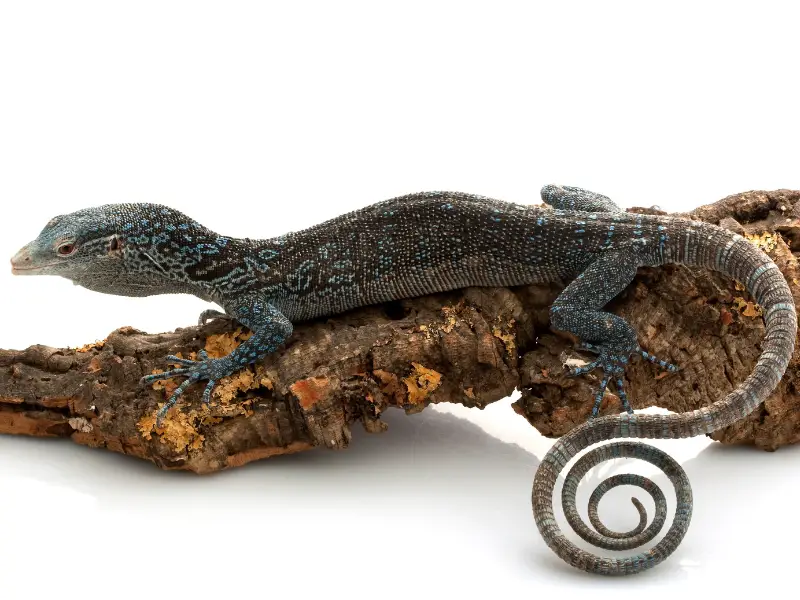
Blue tree monitors are famous for their striking appearance. Their vibrant blue coloring and fascinating patterns have made them a favorite among many reptile lovers.
The moment you see one, you will understand how it got its unique name. While they appear turquoise at first glance, their body’s base is a dark gray to black color. Their belly can be powder blue or dark gray to black like the rest of their body.
They get their unique turquoise color from a series of spots that look like eyes (called ocelli) found across their body. This blue color concentrates on the tip of their snout, which is usually completely blue.
Their scales are smooth on their neck and become keeled (raised and ridged) rings as they get further down the body.
Blue tree monitors are also incredibly long and slender creatures. They have thin limbs ending in delicate digits. They have sharp claws, making them adept climbers as they can easily get a secure grip on rough surfaces like branches.
Their tail is approximately two-thirds of their entire body length and is prehensile. This means that it can grasp branches and other objects like an extra limb.
They can also use their tails as a whip if they feel threatened.
These features make the blue tree monitor one of the most amazing reptiles you could choose as a pet.
Size And Lifespan
Blue tree monitors are considerably long and large reptiles. In fact, they are the biggest monitor in their species grouping.
The average adult male is about 42 inches long (including the tail). Adult females are typically 4 inches shorter than males, averaging 38 inches.
When their basic needs are met and they are given a lot of love and care, blue tree monitors can live up to ten years or longer when kept in captivity.
Temperament
Blue tree monitors are diurnal, which means they are active during the day and sleep at night. They are also arboreal creatures so they are used to spending most of their time up in trees.
Being arboreal reptiles makes them pretty adventurous and they love climbing and exploring.
They are pretty intelligent and will spend most of their day basking, relaxing, and hunting. This active attitude makes them great pets. However, they should be handled appropriately, especially before they’ve familiarized themselves with you.
Blue tree monitors generally prefer to be left alone and can get scared or stressed when excessively exposed to humans and other animals.
They aren’t very aggressive towards humans and are unlikely to bite you. However, they have been known to bite when scared or stressed, often due to over-handling.
Fortunately, these reptiles aren’t venomous, so a bite shouldn‘t be too serious. Just clean it with some disinfectant, cover it, and keep an eye out for infection.
Housing Blue Tree Monitors
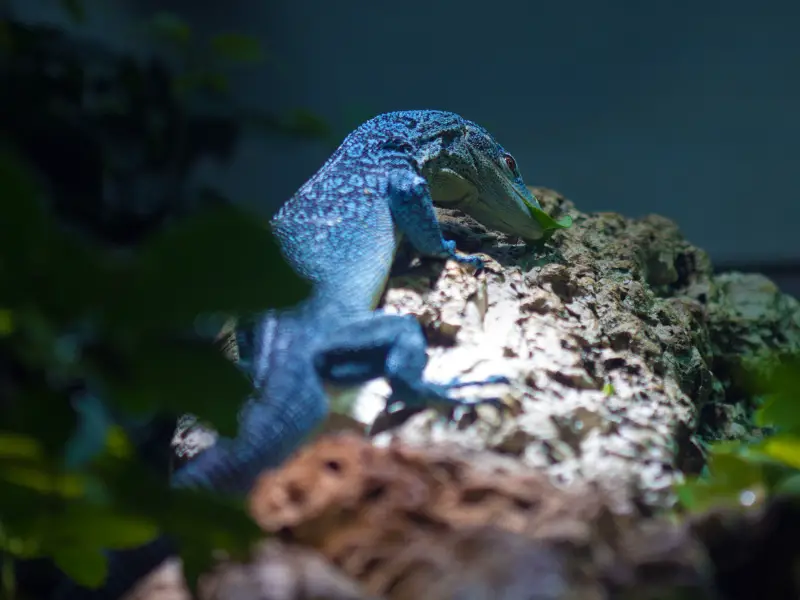
Blue tree monitors come from the tropical forests and jungles of Batanta Island. They are arboreal, meaning they spend most of their life in trees.
They love climbing and adventuring, which needs to be reflected in their enclosure. Ideally, it would be best if you gave them a vivarium with lots of space to explore and plenty of branches and objects to climb.
They are pretty nervous reptiles that can get easily stressed. So it’s best to give your monitor plenty of little hiding places around its enclosure.
Hide boxes and suitable tree trunks work well for this.
Make sure that their hiding spaces are big enough for them to fit in comfortably and move around! If their hiding place is too cramped, this won’t help relieve their stress and can even distress them further.
Blue tree monitors have been known to smash into the glass of their vivarium if they get stressed. This is also the case when they are new to their enclosure.
Installing smokey plexiglass or one-way glass in your vivarium is a good idea. This way, they will feel safer and are less likely to feel stressed and smash against the glass.
Enclosure Size
Blue tree monitors are large and need plenty of room in their enclosure.
There is a myth going around that the size of your enclosure will impact the size of your blue tree monitor. In other words, some people believe that putting your monitor in a smaller enclosure will prevent it from growing to its standard size.
This myth, however, is entirely false. A small enclosure will leave you with an unhappy, stressed, and fully-grown reptile.
If your monitor is younger than 6 months, your enclosure should be at least 18” x 18” by 36”.
After six months, they become adults and will need much more room. Remember, their average size is around 40 inches.
For your monitor to be happy and comfortable, its enclosure should be at least 4’ x 4’ x 2’ but 6’ x 6’ x 3’ is recommended. The bigger the enclosure, the better, especially if you give them lots of things to hide in and climb on.
Lighting
When lighting your blue tree monitor’s enclosure, you need to do your best to mimic the natural sunlight it would experience in its natural climate.
In the wild, these reptiles get UVB light from the sun. So, you will need to install a UVB light to emulate this. Without it, they can develop serious health problems.
You should put the UVB lamp on for 10 to 13 hours during the day and turn it off at night to mimic the natural day-night cycle.
You can get a lamp with a timer that you can set up to do this automatically for you.
This will give your reptile the UVB light to create Vitamin D3 and help your monitor absorb calcium, which is important for its bone health.
Remember, blue tree monitors, live in tropical forests where they receive dappled sunlight. Try your best to use something like a leaf cover to mimic this dappled effect.
Apart from the basking area, the light in the enclosure should be indirect and should not reach the enclosure floor.
Temperature And Humidity
Blue tree monitors are reptiles and, as such, are exothermic. Exothermic means they are cold-blooded and get their body heat from their environment. Because of this, getting the temperature of their enclosure right is essential.
You will need to provide them with a warm basking area and a cooler place to regulate their body temperature as they would in their natural habitat.
This is called a temperature gradient, and getting it right is key to a happy and well-adjusted monitor.
To set up a temperature gradient in your reptile’s vivarium, put your lighting and heating fixtures to one side near the top of your enclosure.
Use lights and heat lamps for the basking area. Avoid reptile heating mats and rocks. Monitors get their warmth from above in their natural habitat, and these won’t do much to warm them up.
Then, you should invest in thermometers that can help you track the temperature of each side.
The basking area of the enclosure should be between 104°F and 108°F. The cooling area (i.e, the rest of the vivarium) should be between 84°F and 100°F. However, at night time, it can drop to as low as 78 °F.
Batanta is pretty humid, and you should mimic this humidity in their vivarium. Ideally, the humidity level should be as close to 80% as possible.
You can achieve this by misting it at various times throughout the day. Alternatively, you can invest in an automatic mister, which is much more convenient.
Regardless of what method you use, you should invest in a hygrometer. A hygrometer is a humidity gauge and will help you track humidity levels to ensure they are optimal for your pet reptile.
Substrate And Decorate
Decorating your blue tree monitor’s vivarium is incredibly important. It needs lots of things to climb on and hide in. Put in some natural branches and plants for it to explore.
If you can’t get your hand on natural plants, fake ones will do the trick. You can also add some horizontal log shelves up the back of the enclosure.
When it comes to the substrate of your blue tree monitor’s vivarium, look for clean, organic substances. Your best option is organic soil that is free from pesticides and chemicals.
If you can’t get your hand on it, bark chips or a combination of soil and sand should do the trick.
The main thing is to avoid taking soil and sand from outside. It could contain bacteria or parasites that may cause serious health problems in your monitor.
Buy the substrate from a pet store to ensure it’s clean and avoid these complications.
These monitors like to soak so provide a large water container that they can climb into.
Cleaning
Spot-clean your monitor’s vivarium as often as possible. Ideally, aim to do so at least every other day.
Also, keep an eye on its water and change it daily. These monitors also like to soak in water, especially when shedding, so it’s important to replace their water frequently.
When and how you change your monitor’s substrate depends on your substrate of choice. As you buy it from the pet shop, chat with them about how often and how you must change it.
You should also stay aware of the overall state of the enclosure. If it starts to smell or look dirty, it’s time to give it a clean!
Blue Tree Monitor Care
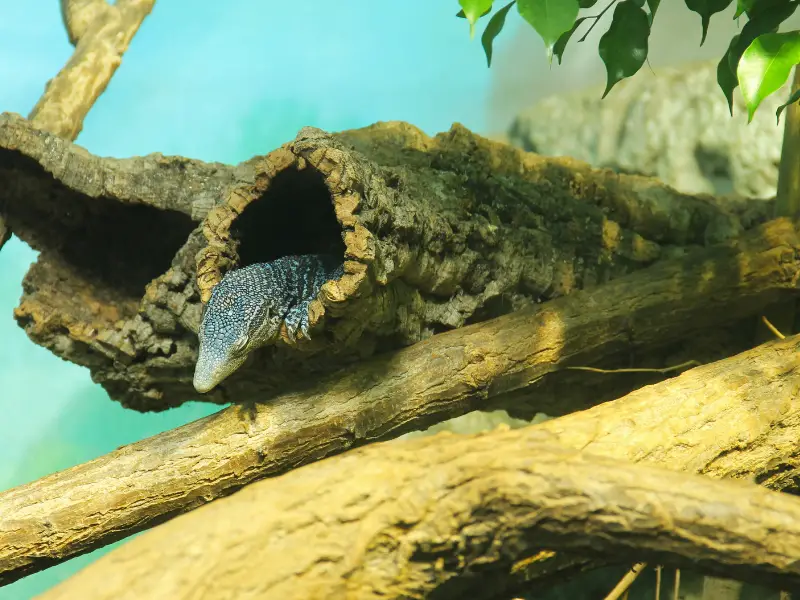
To keep your blue tree monitor happy and healthy, you need to ensure that all its basic needs are met and you aren’t over-handling it.
Make sure you are feeding them a nutritious diet regularly and taking the steps necessary to prevent common health issues.
Food And Water
Feed your monitor a nutritious diet of green vegetables and insects. Give them green vegetables, like spinach, celery, or lettuce, first to ensure they eat them.
These provide a lot of vitamins and will help bulk up their diet.
Then, feed them some insects. Most insects will do, although the most popular ones are roaches, grasshoppers, and crickets.
We recommend dusting them in phosphorus and calcium powder to keep your monitor healthy.
It’s a good idea to feed them insects daily and then throw in a frozen mouse or two at least once a week for added nutrition.
Your monitor will also need a fresh supply of water. They are happy to drink water from a bowl as they prefer drinking from a still, standing water. You need to ensure that it is refilled and changed daily.
Choose a bowl that’s heavy enough so the monitor can’t knock it over, making a mess in its enclosure.
Handling
Blue tree monitors prefer to be handled as little as possible. Some owners have trained them to tolerate short amounts of handling. However, it is unlikely that they will enjoy the process, and we recommend respecting their temperament and only handling them when necessary.
It would also be best if you covered your hands and arms with long sleeves and heavy gloves when you do handle the blue tree monitor.
These monitors have sharp teeth and claws and could bite or scratch you if they get scared or stressed.
Common Health Issues
The blue tree monitor is a robust species, however, like most pets, they can get sick. Here are some health issues that blue tree monitors commonly experience:
- Parasites: Monitors are prone to getting parasites. To avoid complications, you should take them to the vet when you first get them and regularly for checkups.
- Respiratory infections: Monitors can develop respiratory problems if stressed or their living conditions are sub-optimal.
- Infections: Monitors are pretty susceptible to infections from fungus and mold. It could be an infection if you notice anything weird on their skin. Always be on the safe side, and take the monitor to a vet for an inspection.
It’s always a good idea to check if there are experienced vets in your area that know how to treat exotic pets, like monitors.
Breeding
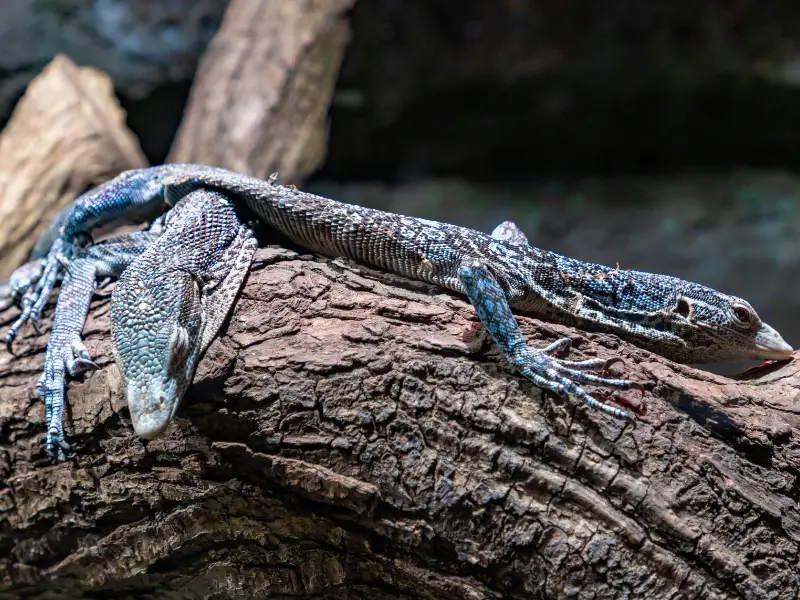
When blue tree monitors are in captivity, the female initiates the breeding process. She will approach the male and bask next to him for a few days to indicate that she is ready to mate.
The mating process will usually take place within the next few days. Once the female blue tree monitor is gravid, she will need a lot of food and water, so make sure you give her a bit extra.
It would help if you also lay out some hide boxes she can use as a nest for her eggs. She should lay her eggs about a month after the mating.
Once she has, remove the eggs immediately and place them in an incubator. The incubator must be 84°F to 86°F. Leave them in the incubator. They should hatch after about 150 days.
Choosing And Buying A Blue Tree Monitor
Unfortunately, blue tree monitors don’t come cheap. If you buy one from a reputable breeder (which we always recommend doing), this monitor could set you back around $2500!
And this price doesn’t even include the costs of setting up its enclosure.
However, if you have the time, money, and expertise for a blue-tree monitor, they are one of the most beautiful reptiles available.
These large, adventurous monitors are great for intermediate to experienced reptile owners who enjoy watching them climb and bask!
If you’re a beginner, we recommend you start off with a beginner-friendly reptile, like a bearded dragon, until you’ve gained enough experience to look after the beautiful blue tree monitor.

